Golejów
Borough of Staszów, Staszowski District, Świętokrzyskie VoivodshipType of place
A forest.Information about the crime
On January 7, 1943, in the forest near Staszów, the Germans organized a manhunt during which an unknown number of Jews in hiding were caught and shot on the spot. Among others, the following died: Rejzla Perla Hauer born 1905 – a woman, two boys Herszla Hauer (b.1927) and Josel Hauer (1930). The document doesn’t provide information about the burial place (IPN BU 2448/381 p. 124).
In the forests around Staszów, there is an unknown number of unmarked Jewish war graves of Jews from Staszów and other villages seeking rescue from deportation to death. In 2020, we met Zofia, who lives next to unmarked graves and became their informal caretaker and guardian:
“These people were from Staszów and they ran away to the forest. He showed me this pit and G. also talked about it. There is still a pit next to the roadside post. There is water there, a road is being built over there, and half of that pit is on the construction site, but that depression is still there. I’ll say what I know. They were young boys, up to fifteen years old. The German ordered them to dig a hole for themselves. He was reading a book, and they were digging the hole in a terrible panic. They were guarded there and they were supposed to dig this hole.
– How many people were there?
– Fifteen boys who lived in the market square.
– Only the youth?
– Yes. They are buried there, they dug [the grave] for themselves. […] A German was sitting here, it was guarded by the other Germans, and these poor boys were digging. They were young, fifteen, sixteen, up to twenty years old. There were about fifteen of them, maybe even more. This is what she [an eyewitness] said, she hid somewhere and watched, because they [the Germans] wouldn’t let anyone near them. The German was reading a book, and these poor boys were digging a hole, crying and mourning.” (Golejów, October 20, 2020)
Zofia described this place to a Dutch journalist in similar words: “These boys are buried here. About fifteen. They weren’t yet twenty. They had to dig their own grave. That German was sitting there reading a book.” (Overbeek, 20/10/2021)
Near the grave of fifteen boys, there is the grave of five Jews from Staszów in a place that was undetermined before: “About fifty Jews who were going to Skrzypiec were buried in this ditch. They are buried a little further, the ditch is shallower there. At the moment, the house is being built in front of it. At that time, there was no forest here, just bushes. I want to show you which place it is. […] Those people who fled here to the forest in Skrzypiec, were caught, murdered and buried here. I also heard that they lived in the market square. These were people in powerful positions.” (Golejów, October 20, 2020)
A note about the grave of fifty Jews from Staszów can also be found in Overbeek’s article: “Several dozen meters away there is an even larger grave. The pit almost disappeared as if it had been covered with soil. If the data is correct, the bodies of about fifty executed Jews are buried there.” (Overbeek, Oct 20, 2021)
The body of an unknown man is buried in another unmarked grave indicated by Zofia: “It was a young boy, nicely dressed, but they took his clothes. As far as I know, he was buried wrapped in a blanket… […] I know for sure there’s a grave there. It’s definitely there, next to this ditch. There was a dugout over there, the Jews were hiding behind this embankment. It’s definitely here, where the mulch is. I raked it, but it’s already covered again. I guess it’s not in the ditch but next to it.” (Golejów, October 20, 2020)
The remains of a murdered Jew were buried by Zofia’s father: “It was a well-dressed young man. My father said that he didn’t bury him right away, because the Germans were still sneaking around. One night my father went to bury him. He showed me this place.” It is a shallow ditch along a dirt road at the edge of the forest. (Overbeek, 10/20/2021)
The last grave that Zofia looks after belongs to an unnamed Jewish woman who probably gave birth to a daughter before the end of the war and was then murdered. Zofia suspects that she may be this child. This is how Overbeek described the story:
“There is only one grave left. [Zofia] knows where it is, because her mother always pointed it out with the words: there is a Jew buried there. This one person was not a Jewish man, but a Jewish woman, who wasn’t murdered by the Germans. Zosia couldn’t hold back her tears. Here lies my mother. […] This Jewish woman was hiding. Nobody knew her name. She was pregnant. The child’s father was Zosia’s “uncle”, the brother of the man she always called her father. Probably in the cold December 1944, an emaciated Jewish woman knocked on the door of the former midwife’s house. It was a hard labor. They called Zosia’s “father”. He was furious and beat the exhausted woman to death. He thought the baby was dead, but when she started crying, he took her. Only a few years after the war, she was given the name Zosia and her official date of birth: October 22, 1947. The date was not accidental. The Catholic family chose the Marian apparition day for the birthday of a Jewish child […] She was about six years old when her father opened the hatch in the floor and pulled out the chest. He took out a roll with strings. I took it and asked: what is it? – You got it from your mother. It’s Torah. Then he snatched it from my hands. I had never seen it again. What was the Torah? And which “mother” did her father mean? Sometimes she was eavesdropping on fragments of conversations. Her uncle “raped the Jewish woman”. Her father “ran furiously to the midwife’s house”. She then noticed that her uncle loved looking after her children. According to her new life story, her “uncle” was her father and her “father” was the murderer of her real mother. She rarely uses the word “father”. Instead, she uses his last name, which is also her own. He protected me from my mother [stepmother]. When he was away from home, she was at the mercy of the “mother” who raised me. She beat and abused me. I was living in hell. One by one, Zosia puts the pieces of the past together like a puzzle. Some are unclear – others are sharp as a razor and painful. Some connect smoothly, others stay in an empty space full of questions. Did her family help the hiding Jews or did they take advantage of their misfortune? Or maybe both? They did not betray the people hiding in the forest. But how did these Jewish valuables get under the floor of their home? What did Zosia’s “uncle” have in common with hiding the Jewish woman? Was he “her lover”, as she calls him several times? Was it hopeless, romantic love between a Pole and a hiding Jewish woman, a relationship punishable by death during the occupation? Or was it a Jewish woman raped by Zosia’s “uncle”? And one more big mystery: why did Zosia’s “father” beat a hiding Jewish woman to death, and then protect her child all his life? Was she screaming during childbirth and was he afraid that the Germans would come? Did he give her the final blow to end her unnecessary suffering? Or maybe he was “broken”, as Zosia suggests, because he was “tortured by the Gestapo”? […]. But why was he taking care of the baby then? Was it because of the remorse for murder? Or was the child allowed to live because it was his own body and blood? But why didn’t his brother, who was her real father, raise the girl? […] Zosia’s stepmother began to see ghosts shortly before her death. I came back from the church – says Zosia. She looked at me with bulging eyes and shouted: “How did you get here? Did you come for the baby?” She saw my mother in me. I probably look like her. Zosia got angry and asked: Where is my mummy? But she got no reply. It was eight years ago. The answer came three years later. The former neighbor didn’t want to take this secret to the grave. He was there when I was born. He was an eyewitness. He also knew something else. My mother named me Armina. Zosia-Armina wears a necklace with a crucifix. There are images of Catholic saints on the mantel. But if her mother was Jewish, she is actually Jewish too. What is it like to know about it now? She thinks for a moment. Then she says: I am happy. I never knew my mother, but it gives me confidence. (Overbeek, 10/20/2021)
Commemoration
The place of the grave was marked with a wooden matzevah in 2020 as part of the project “Reference points – marking 24 Jewish war graves with wooden matzevot ”. The project is an attempt to find a way of marking these sites before they can be commemorated. Marking forgotten Jewish war graves with wooden matzevot is a subtle intervention in the landscape reminding about what remains invisible, yet present in the memory of local communities. Being only a temporary commemoration, wooden matzevot invite local communities to discuss and take action, to discover the places, and perhaps to start their own memory practice related to them or to initiate a permanent commemoration.
You can read more about the project here: https://tinyurl.com/2p9ar52f
The project was implemented thanks to the funding from The Association of the Jewish Historical Institute of Poland (Stowarzyszenie Żydowski Instytut Historyczny) and The Matzevah Foundation.


IDENTIFICATION OF THE GRAVE BASED ON NON INVASIVE RESEARCH
On October 5, 2020 and November 3, 2020, a site inspection was carried out in the presence of a local woman, who indicated four locations of burial sites of the Jewish victims of the Holocaust.
Grave no. 1
The first location (GPS: N 50 ° 33.389 ‘E 021 ° 12.189’) was precisely identified as the mass grave of fifteen young men. The location is very characteristic due to the roads intersecting in this place. Moreover, it is the edge of the forest bordering private properties. The area indicated after the vegetation had been cleared, revealed slight unevenness that may be a remnant of the original grave. The place has been tested with the use of GPR. An anomaly with approximate dimensions was recorded on the GPR profiles (GOL30001-GOL30004): length 4.5 m, width 2.5-3.0 m, depth 1.1 m below ground level.
Grave no. 2
The second location (GPS: N 50 ° 33.345 ‘E 021 ° 12.144’) is an approximate indication of the mass grave of about fifty victims of the Holocaust. The place is located on the road running along the forest and private properties. There is noticeable depression of the ditch located at this point. It may have been used to bury the remains of the victims. The location requires further search for potential witnesses who could indicate the precise location of the burial site.
Grave no. 3
The third location (GPS: N 50 ° 33.256 ‘E 021 ° 12.127’) was indicated as the approximate site of a grave of a woman. This place is located between arable fields and a young forest. The designated area is close to the road that runs along the forest.
Grave no. 4
The fourth location (GPS: N 50 ° 33.131 ‘E 021 ° 12.183’) has been indicated as the approximate site of a grave of one man. The designated area is in a forest with no direct access to the road.
Aerial photography query for this area wasn’t ordered.
The relief survey (LiDAR) is not helpful at this stage of the search.
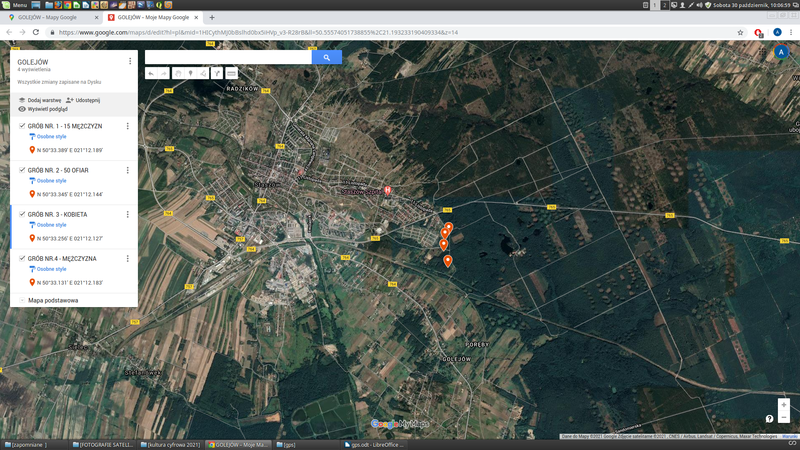 Zrzut ekranu nr 1 z 2021-10-30 - Golejów
Zrzut ekranu nr 1 z 2021-10-30 - Golejów Lokalizacja grób nr 1 a - Golejów
Lokalizacja grób nr 1 a - Golejów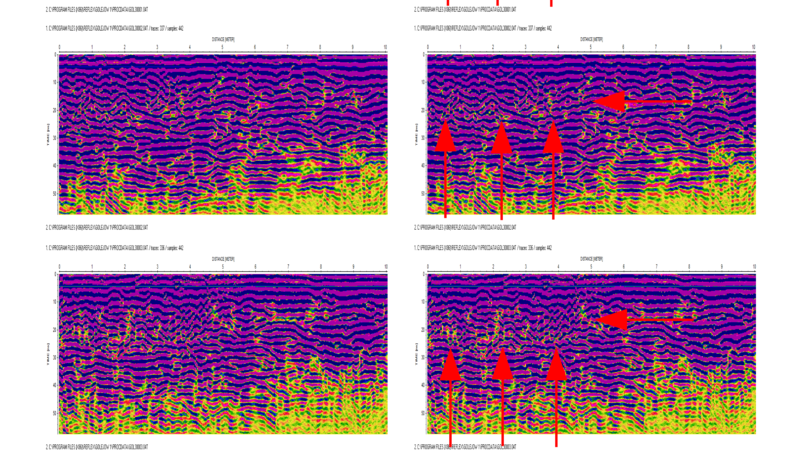 Echogramy GOL3 - Golejów
Echogramy GOL3 - GolejówSources
Transkrypcje
Contact and cooperation
We are still looking for information on the identity of the victims and the location of Jewish graves in Golejów. If you know something more, write to us at the following address: fundacjazapomniane@gmail.com.
Bibliography
IPN BU 2448/381 pt. 1, pp. 2, 3
IPN BU 2448/831 pt. 2, pp. 1, 2, 15-20
Ekke Overbeek “Het Poolse bos geeft een geheim prijs” October 20, 2020 www.trouw.nl
https://www.trouw.nl/verdieping/duizenden-slachtoffers-van-de-sjoah-liggen-nog-verborgen-in-de-poolse-bossen~bd3b60ed/ access date: November 8, 2021
Recording of the Zapomniane Foundation (audio file), Zofia, a resident of Golejów, keywords: Jewish war graves in the forest around Golejów; exp. Aleksander Schwarz, Golejów, Autumn 2020
We have collected the materials about this village thanks to the funding provided by the International Holocaust Remembrance Alliance as part of the project “The rural Holocaust. Collecting and safeguarding the never recorded testimonies 100 forgotten Jewish graves 2021-2022” and also thanks to the support of the Embassy of the Federal Republic of Germany in Warsaw.
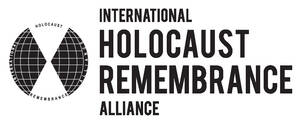
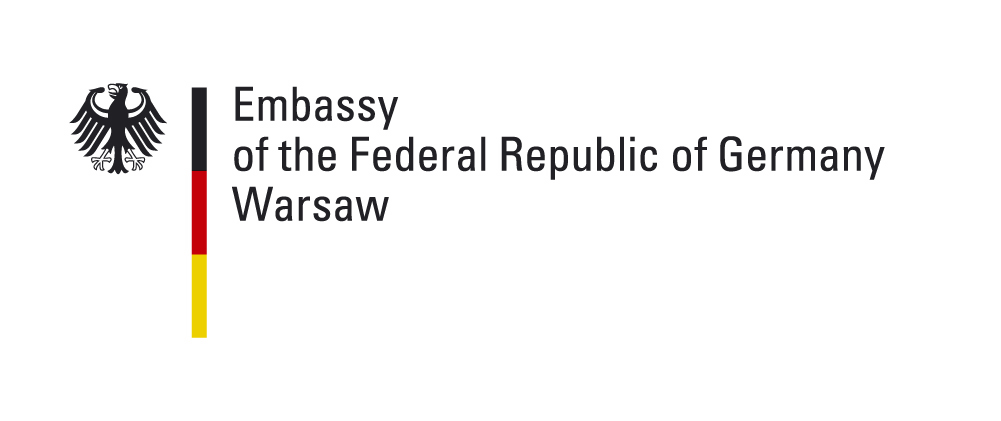
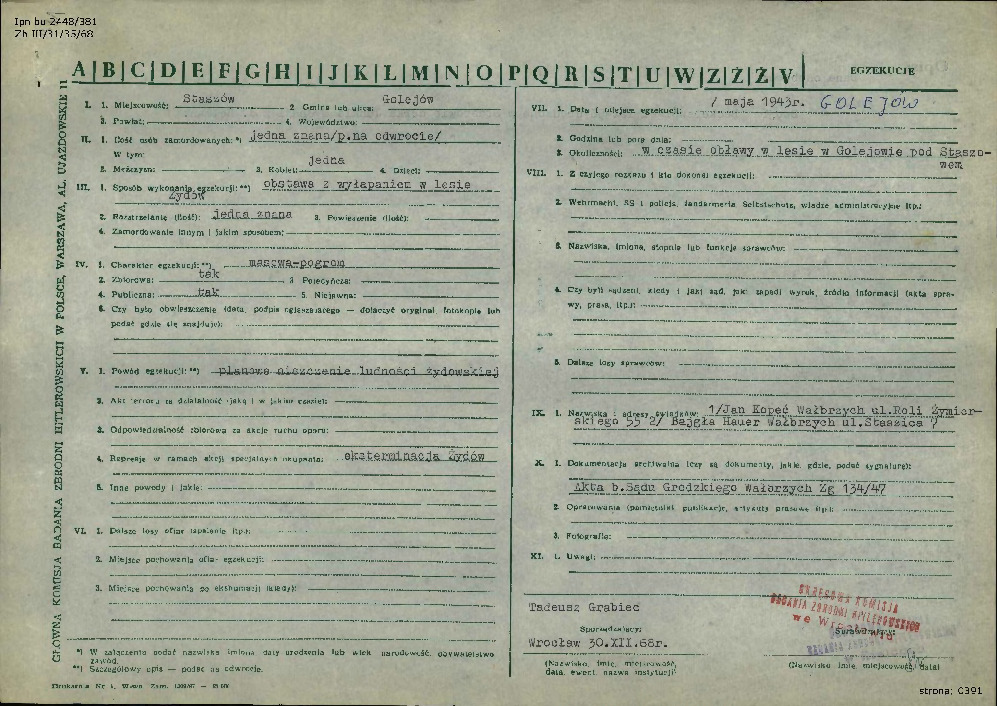 Ankieta Głównej Komisji Badania Zbrodni Hitlerowskich - Golejów
Ankieta Głównej Komisji Badania Zbrodni Hitlerowskich - Golejów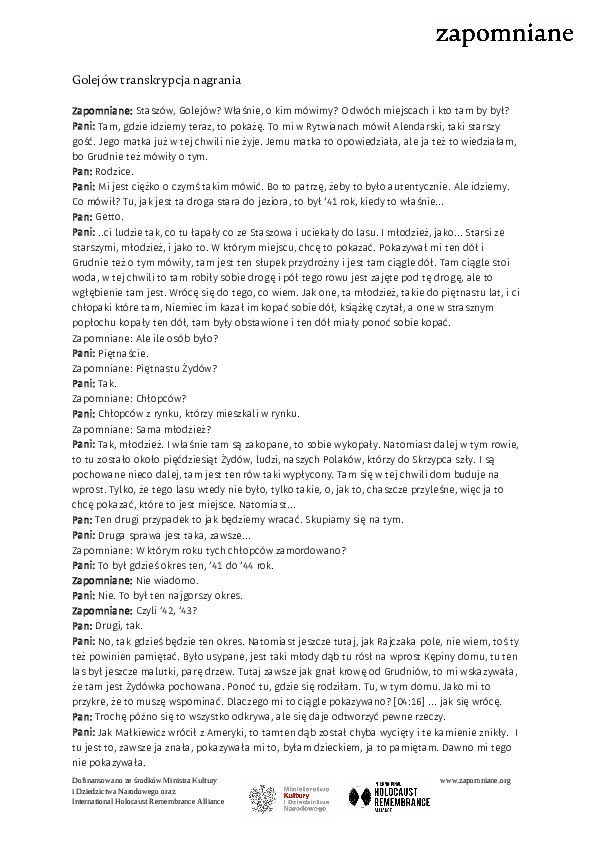 Golejów transkrypcja nagrania
Golejów transkrypcja nagrania